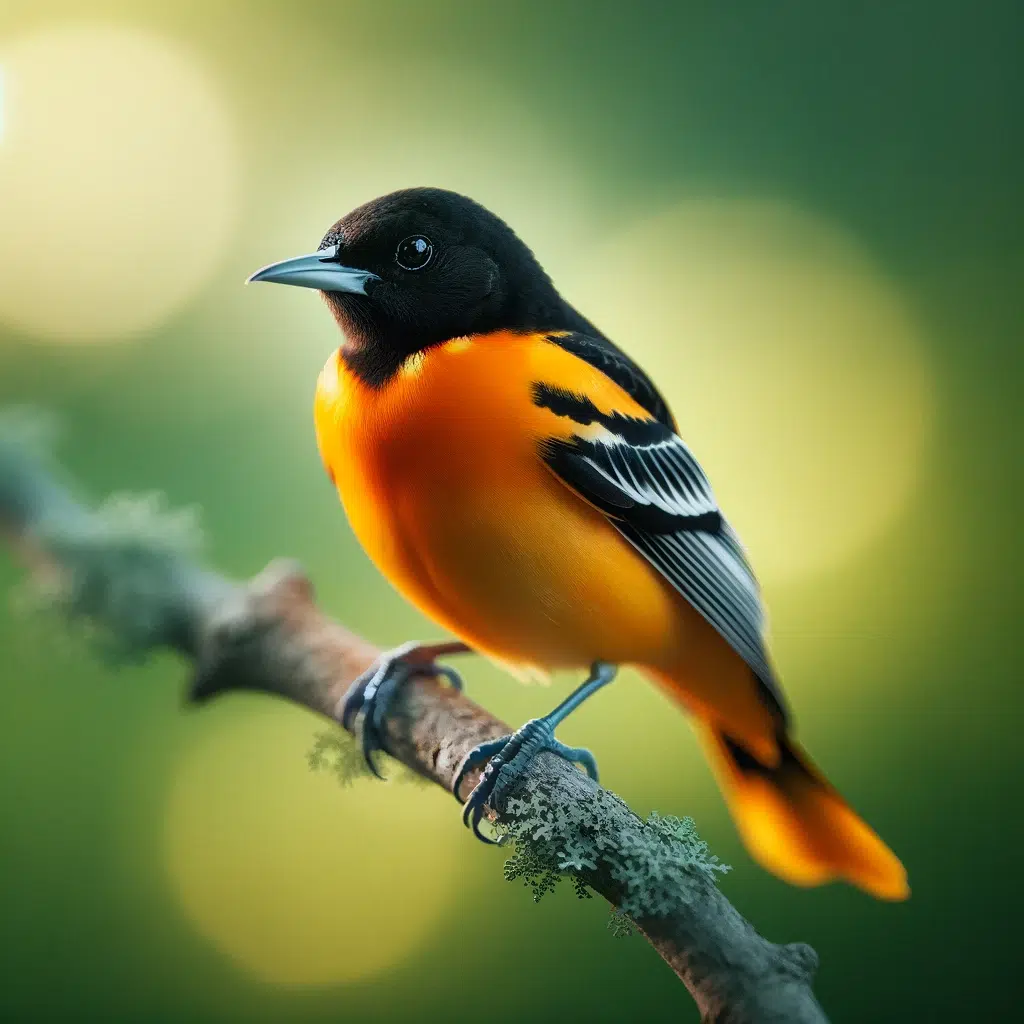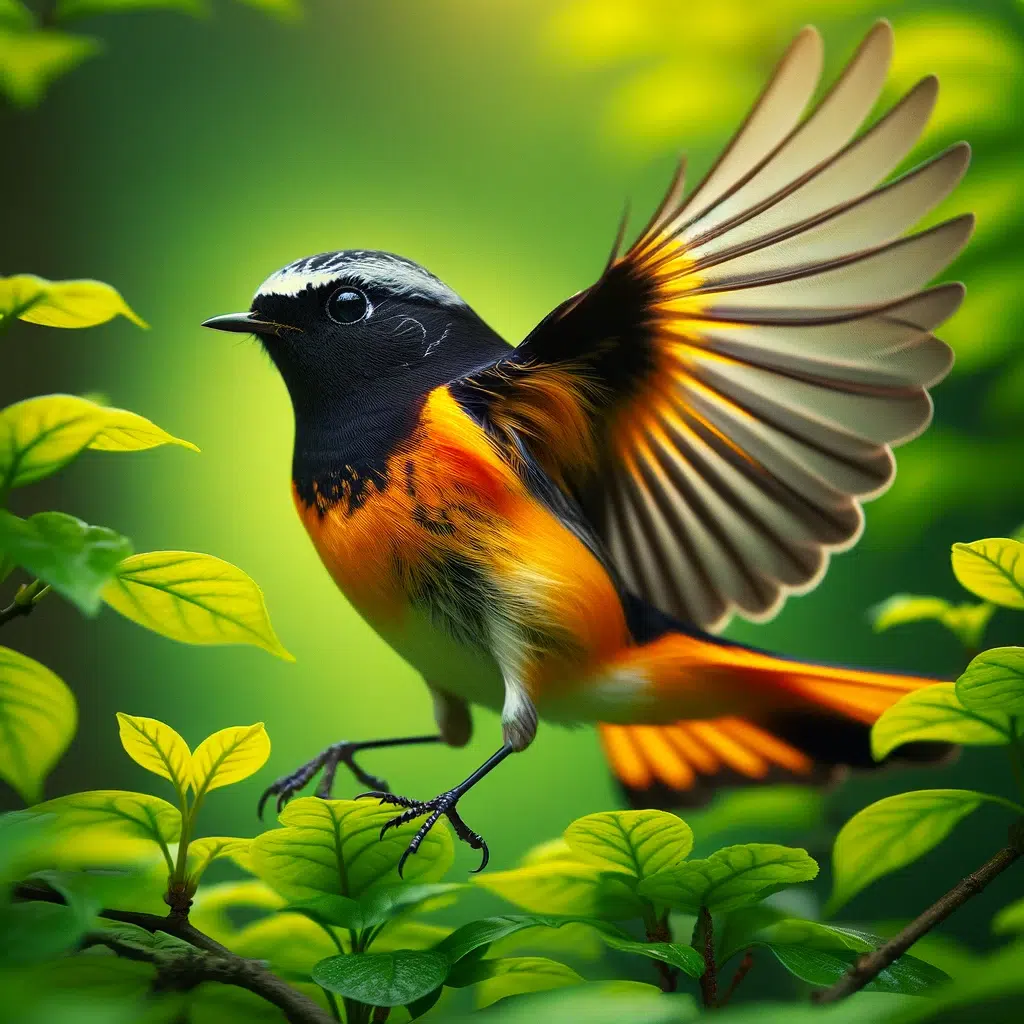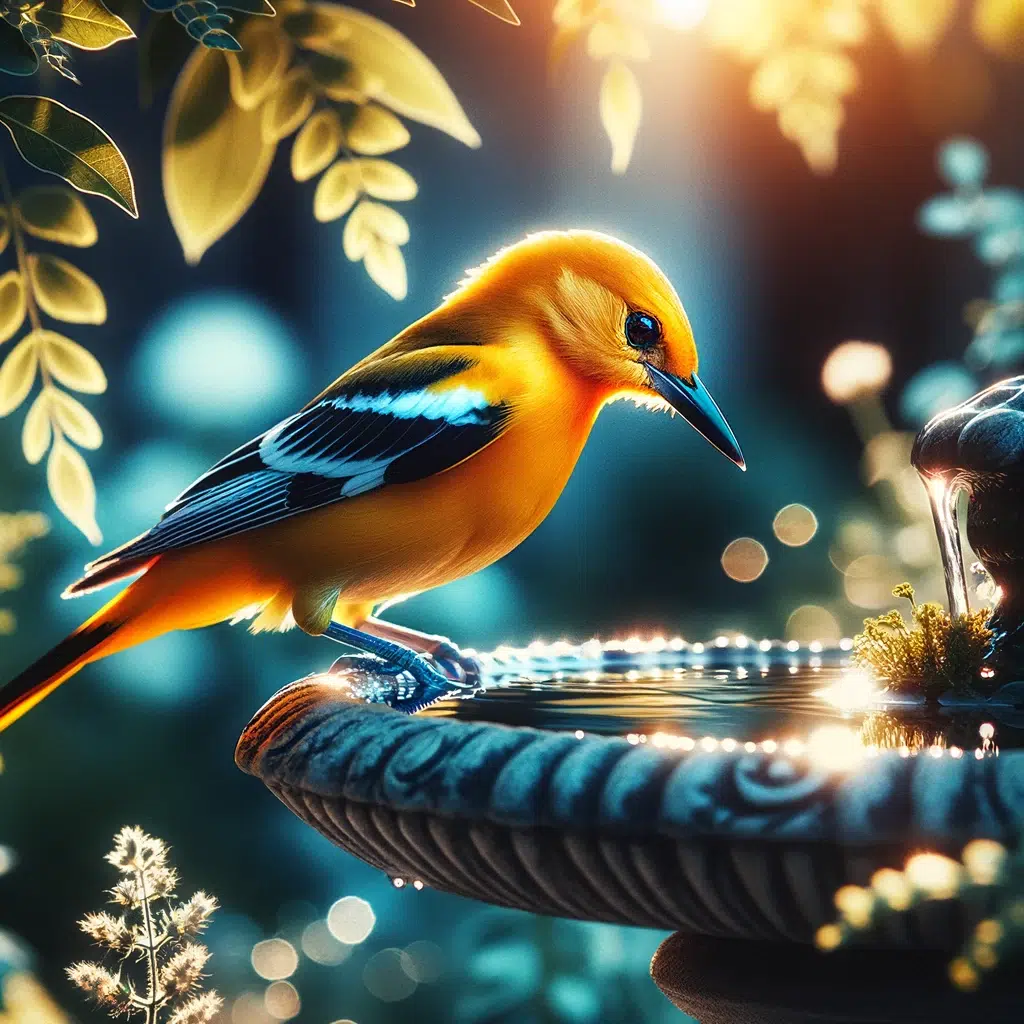Orange and black are two of the most striking colour combinations in the bird world. Several beautiful and fascinating bird species across North America sport these bold and contrasting colors, adding a splash of vibrant hues to forests, wetlands, and even our own backyards. Black and orange birds are different from other species, From the well-known Baltimore Oriole to the more elusive Varied Thrush, orange and black birds captivate birdwatchers and nature enthusiasts alike. In this article, we’ll explore some of the most remarkable oranges and blackbirds, learn about their unique characteristics, and discover why these stunning creatures are so important to the ecosystems they inhabit.
Why are some birds orange and black?
Many bird species’ bright orange and black coloration serves important purposes beyond being aesthetically pleasing. The bold orange is often a warning sign to predators, indicating that the bird may be toxic or unpalatable. The contrasting black markings help break up the bird’s outline, providing camouflage among foliage and shadows.
For some species, like the Baltimore Oriole, the bright colours also attract mates. Females frequently consider males with the most vivid orange plumage the most desirable. Interestingly, birds get their orange color from their diet, often from eating foods rich in carotenoids like berries, insects, and nectar.
The iconic Baltimore Oriole

The Baltimore Oriole is perhaps North America’s most well-known orange and black bird. Found throughout the eastern United States and parts of Canada in summer, the male Baltimore Oriole is a breathtaking sight with its deep orange underparts, black head and back, and bold white wing bars. Females are more muted in color but still lovely with their yellowish-orange breasts and greyish wings.
Baltimore Orioles are known for their melodious whistling song and intricately woven hanging nests, which they build high in leafy deciduous trees. These birds migrate to Central America, northern South America, and the Caribbean for the winter. To attract Baltimore Orioles to your yard, try putting out fresh orange halves, grape jelly, or a sugar-water feeder.
The flashy American Redstart

The American Redstart is another eye-catching orange and blackbird, a lively warbler species. Male redstarts are mostly glossy black, with bright orange patches on the sides, wings, and tail and a white belly. Females have gray heads and backs, yellow patches instead of orange, and white wing bars.
American redstarts breed in deciduous forests across the eastern and northern U.S. and Canada. They are active, flicking their wings and fanning their tails to startle insect prey. They migrate to Central America, northern South America, and the Caribbean in winter. While they don’t visit bird feeders, you may spot them during migration as they forage for insects among the trees.
The melodious Orchard Oriole

The Orchard Oriole is a smaller cousin of the Baltimore Oriole found in orchards, open woodlands, and backyards across the eastern U.S. in summer. Male Orchard Orioles are chestnut-orange on the underparts and rump, with a black head, throat, back, and wings. Females are yellowish-green with white wing bars.
Orchard Orioles weave beautiful pendant nests, often in trees along rivers and streams. They have a rich, whistling song that is faster and more warbly than the Baltimore Oriole’s. These birds spend the winter in Mexico and Central America. Orchard Orioles occasionally visit nectar feeders and are attracted to cut oranges and grape jelly put out for orioles.
The bold Bullock’s Oriole

Bullock’s Orioles are the common orange and black orioles of the western United States. They look similar to the Baltimore Orioles but have a slightly different facial pattern, with an orange eyebrow and more white wings. Females are yellowish overall with grayish wings.
These birds breed in open woodlands and parks, often along streams and rivers. They weave intricately woven hanging nests in tall deciduous trees. Bullock’s Orioles migrate to Mexico for the winter. You can attract them to your yard with sugar water feeders, cut oranges, and grape jelly.
The striking Hooded Oriole
Hooded Orioles are stunning birds in the southwestern U.S. and the West Coast. Males have bright orange faces and underparts with a black “hood”, back, and wings. Females are more subdued in color, with yellowish underparts and olive-gray upperparts.
These orioles frequently nest in palm trees, weaving their nests from palm fibres. They have a slow, whistling song and spend the winter in Mexico and Central America. Hooded Orioles will visit nectar feeders and are attracted to ripe fruit like oranges.
The surprising Black-headed Grosbeak
While not a true orange and blackbird, the Black-headed Grosbeak deserves an honorable mention. Males have a bright orange breast and collar with a black head and wings, making for a striking color combination. Females are brown and white with an orange wash on the breast.
Black-headed Grosbeaks breed in the western U.S. and migrate to Mexico for the winter. They inhabit open woodlands and visit backyard bird feeders for sunflower seeds. Listen for their rich, robin-like song in summer.
The dazzling Western Tanager
Another honourable mention goes to the Western Tanager, a bird that looks like it was dipped in bright orange paint. Males have flaming orange-red heads, yellow bodies, and black wings with two bold wing bars. Females are much more subdued, with greenish-yellow plumage.
Western Tanagers breed in the open coniferous forests of the western U.S. and spend the winter in Mexico and Central America. They forage for insects among the treetops and occasionally visit backyard feeders for fruit. Their song is a series of short, burry phrases.
The ubiquitous Red-winged Blackbird
Without mentioning the Red-winged Blackbird, no discussion of orange and black birds would be complete. While males are mostly glossy black, they sport brilliant red and yellow shoulder patches that flash when they fly or display. Females are brown and heavily streaked, often mistaken for large sparrows[.
Red-winged Blackbirds are found in North America’s wetlands, fields, and marshes. Males are highly territorial and aggressively defend their nesting areas from intruders, including much larger animals and even people. In winter, they form huge flocks that can number in the millions. You can attract Red-winged Blackbirds to your yard with mixed grains and seeds spread on platform feeders or the ground. Check out the Dune Lark and its similarities with these species.
The elusive Varied Thrush
The Varied Thrush is a striking orange and black bird that can be tricky to spot. Males have a deep orange breast and eyebrow, with a black breast band, head, back, and wings. Females are similar but duller in color.
Varied thrushes breed in the dense coniferous Pacific Northwest and Alaska forests. They are shy birds that often stay hidden in the understory, foraging for insects and berries on the forest floor. In winter, they may visit backyards and parks in their range, especially during harsh weather. Listen to their haunting, flute-like song echoing through the misty forests.
Attracting orange and blackbirds to your yard
Many orange and black bird species are migratory, so the best time to look for them is during the spring and summer breeding seasons. To attract orioles and tanagers to your yard:
- Put out specialised nectar feeders designed for orioles, filled with sugar water
- Provide cut oranges, grape jelly, and mealworms in a shallow dish or tray feeder
- Plant native fruiting trees and shrubs like mulberries, serviceberries, and elderberries
- Avoid using pesticides to ensure a healthy insect population for birds to feed on
With a little luck and the right natural habitat, you may be rewarded with a glimpse of these stunning orange and blackbirds!
The importance of orange and black birds
Beyond their beauty, orange and black birds play crucial roles in the ecosystems they inhabit. As primarily insectivorous birds, orioles, tanagers, and warblers help control insect populations, including many pests that can damage trees and crops. Their foraging activities also help disperse seeds and pollen, contributing to the health and diversity of plant communities.
Unfortunately, many orange and black bird species face threats from habitat loss, climate change, and other human-caused pressures. For example, the Baltimore Oriole has experienced significant population declines in recent decades, likely due to the loss of nesting trees and the use of pesticides that reduce insect prey. Conservation efforts, such as protecting and restoring critical habitats and promoting bird-friendly practices in agriculture and landscaping, are essential for ensuring the long-term survival of these remarkable birds.
In summary
- Orange and black birds get coloration from their diet for camouflage, warning, and mate attraction.
- Baltimore Orioles are the most iconic orange and black birds, known for their hanging nests and melodious song.
- American Redstarts are hyperactive orange and black warblers constantly flitting their wings and tails.
- Orchard Orioles are smaller orioles with rich chestnut-orange and black coloration.
- Bullock’s Orioles are the common orange and black orioles of the western U.S.
- Hooded Orioles have striking orange and black hoods and frequently nest in palm trees.
- Black-headed Grosbeaks and Western Tanagers also have eye-catching orange and black plumage.
- Red-winged Blackbirds are widespread and known for their aggressive territorial defence.
- Varied Thrushes are elusive orange and black birds of the Pacific Northwest.
- Attract orioles and tanagers with nectar feeders, cut fruit, and natural habitat with native fruiting plants.
- Orange and blackbirds are important for controlling insect populations and dispersing seeds and pollen.
- The loss of habitat and other human impacts threaten many orange and black bird species.
- Protecting and restoring critical habitats is essential for the conservation of these remarkable birds.
From their bold coloration to their lively songs and behaviours, orange and black birds are some of North America’s most captivating and ecologically important birds. By learning about these special species and taking steps to protect them and their habitats, we can help ensure that future generations will continue to marvel at their beauty and witness their vital roles in the natural world.
So, the next time you spot a flash of fiery orange in the treetops, take a moment to appreciate the remarkable orange and black birds that brighten our skies and enrich our environment.
FAQ
What are some common types of orange and black birds?
Oriole, Red-winged Blackbird, American Robin, Baltimore Oriole, American Redstart, Orchard Oriole, Altamira Oriole, Hooded Oriole are some of the orange and black birds commonly found.
Where are orange and black birds usually found?
Orange and black birds are often found in open woodlands and various habitats throughout North America, particularly in regions like Mexico and Central America.
What are the distinctive features of orange and black birds?
Orange and black birds typically exhibit striking orange plumage with contrasting black wings, black head, sometimes with black throat and orange breast. They may have white wing bars, wing patches, and white bellies.
Do orange and black birds have a specific breeding season?
Yes, orange and black birds, like the Baltimore Oriole and Orchard Oriole, typically have a specific breeding season during spring and summer.
Are there any resources to learn more about orange and black birds?
Cornell Lab of Ornithology and various books on ornithology and birds of North America are valuable resources for learning more about orange and black bird species and their characteristics.
